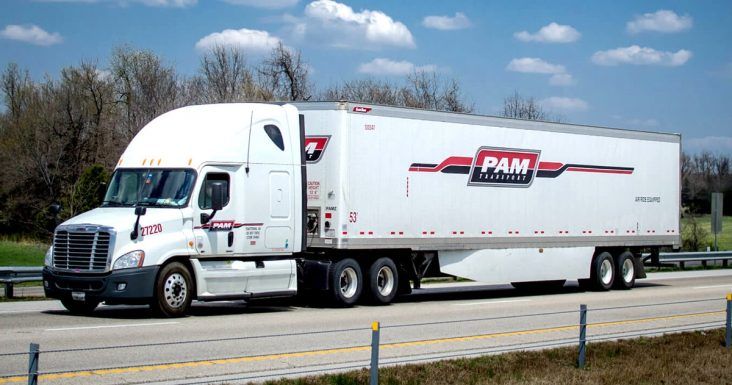P.A.M. earnings per share hit first-quarter record, net income up nearly 500%
by April 15, 2019 8:05 pm 952 views

P.A.M. Transportation Services earnings per share rose to a record level as the company acquired higher rates from customers amid bad weather and expected plant closures.
The Tontitown-based carrier reported before the markets closed Monday (April 15) net income rose 498.5% to $8.3 million, or $1.39 per share, in the first quarter, from $1.39 million, or 22 cents per share, in the same quarter in 2018. Revenue increased by 7.7% to $128.69 million.
The carrier’s operating ratio, which is expenses as a percentage of revenue, improved to 90.95% in the first quarter, from 96.37% in the same period in 2018. Revenue per mile rose 14.5% to $1.66. Total loads increased to 99,525. The number of company trucks increased by 18.2% to 1,457, and the number of owner-operator trucks rose 5.8% to 582.
Logistics operations revenue rose 9.4% to $20.332 million. Operating ratio in the logistics segment improved to 92.4%, from 95.5%.
“We are very pleased with our first quarter results,” President Daniel Cushman said. He explained the first quarter is often challenging because of the weather and customers closing plants, and this quarter was no exception, with several bad weather events and customers closing plants for maintenance and re-tooling. “Despite these challenges, we were able to produce results that now stand as the company’s most profitable first quarter. These record results mark the fourth consecutive quarter of record earnings per share results for their respective periods, excluding the effect of the adoption of the tax reform law enacted in the fourth quarter of 2017.”
The higher customer rates have allowed the company to offset rising costs that the company has experienced over the past three years, Cushman said. Some customers have put pressure on the company to reduce rates, but the company hasn’t done that and doesn’t plan to, citing rising costs such as driver pay, fuel, insurance and equipment. Rate reductions would lead the company to “unacceptable margins,” he said. The driver pay increases the company has given over the past two years is a cost that can’t be rolled back and must be recovered through higher rates. Cushman expects more driver pay increases in 2019. The company continues to add new business at target margins.
Market demand and rates remain at record highs for the company’s Mexico service, and the recent border crossing issues didn’t have an impact on the first quarter but did lead to delays in early April, Cushman said. The company has a clearance designation, allowing it to travel in northbound lanes that have been less impacted than other lanes.
The volume and rate for the company’s expedited business declined in the first quarter of 2019, from the fourth quarter of 2019. Demand for the service remains with existing customers and new customers, largely in the substitute linehaul sector for small packaging companies but also some demand for customers who need driver teams, Cushman said.
The company’s logistics segment is expected to continue to grow, and the company recently purchased property adjacent to its headquarters to allow for continued growth in the segment, he said. The company increased the size of its fleet by 20% in 2018, and while the fleet will grow in 2019, it won’t increase at the 2018 level this year.
Shares of P.A.M. (NASDAQ: PTSI) closed Monday at $54.06, up 41 cents or 0.76%. In the past 52 weeks, the stock has ranged between $70 and $33.29.
TRUCKLOAD RATES RISE
Truckload linehaul rates rose 4.8% in March, from the same month in 2018, according to the Cass Truckload Linehaul Index. The rates represent a mixture of contract and spot rates, and the index value was 139.9.
“We expected continued increases in coming months, but at slightly lower percentage increases, as comparisons grow increasingly tough in coming months,” said Donald Broughton, analyst and commentator for the Cass Indexes. “We are lowering our realized pricing forecast for 2019 from 2% to 5% to 1% to 3%.”
Spot rates briefly reached a peak above contract rates in 2018, and have since fallen below contract rates by a margin that is likely unsustainable, Broughton said. But if and when they rise, the rates continue to put negative pressure on contract and realized pricing.
